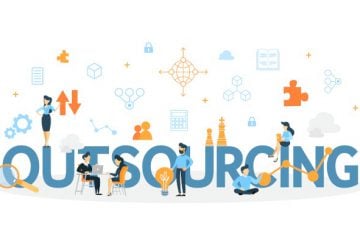About 100 years ago, being a sales representative was a pretty simple job. A sales representative, or a salesperson sold products and services, and in the process made himself some money, and his employer even more money. SDRs didn’t exist, and neither did outsourcing. It is not that simple now.
The sales industry, especially the B2B sales industry now necessitates highly specialised sales roles like Sales Development Representatives (SDRs), Business Development Representatives (BDRs), sales account managers, sales account executives…you get the gist.
If you run a Business-to Business (B2B) sales company, your sales team has one of the most difficult jobs in the world: Turn complete strangers into paying customers…and retain them.
And in most companies, this is the job of an SDR, or a Sales Development Representative. And another decision is whether you should outsource them or hire them in-house, which something you might make up your mind about by the time you’re done with this article.
What are SDRs and What Do they do?
A Sales Development Representative (SDR), or a Business Development Representative (BDR), is one of the many roles in a sales team. Their main sales goal is to analyse and gather prospects through demand generation activities and use them to generate leads for other sales executives to close.
SDRs work to generate leads and prospects who are interested in potentially buying your company’s product or services, and lay in the groundwork with these generated leads by gauging interest and offering value in what they’re providing. Once that’s done, a sales or a business executive closes the deal with the client over the phone or in an in person meeting.
Think of it this way: An SDR is like a station chef who prepares all the ingredients, and finely cuts all the vegetables, and makes sure everything is working for the sous chef to come in and work his magic to make a mouth-watering vegetable chop suey. Except sadly, a station chef can’t be outsourced.
SDRs and BDRs are one of the main lead generators for most SaaS Companies and B2B business.
“But then why are most companies opting for SDR Outsourcing?”
Which is why we’re going to look at some statistics about SDR Outsourcing:
4 Things You Need to Know About SDR Outsourcing
- HIGH TURNOVERS IN AN IN-HOUSE TEAM
Being an SDR or a Sales Development Representative is a difficult job. Huge performance ramifications handed to new junior sales staff with not much experience as frontline sales workers. And you don’t only have to pay SDRs, you have to manage them. Which is another opportunity cost shouldered by the sales management aside from the cost of an in-house SDR team.
As per a Bridge Group report, turnover rates for SDRs are an average of 39%, a rate which shoots up even more if you’re a high-growth company.
With such a high turnover rate, partly because of involuntary terminations, many B2B businesses and SaaS companies have opted for SDR outsourcing to offshoring companies which specialise in setting up outsourced sales teams.
- COST-BENEFIT ANALYSIS OF SDR OUTSOURCING
According to the same Bridge Group report, an in-house sales development representatives average tenure is just about 20 months.
Hiring an SDR costs an average of about 50% more on a company’s annual salary. However, the cost of hiring a new sales representative or BDR during a sales team turnover can shoot up to even 200% of an employee’s annual salary… which is another way of saying you shouldn’t underestimate the high cost a sales team turnover.
Compare this to SDR outsourcing and the difference is startling. Once you opt for BDR or SDR outsourcing, you can scratch off the costs of recruiting, onboarding, training, and retaining.
Compared to an in-house SDR team as the focal point of your lead generation, an outsourced team of sales representatives or BDRs is a no brainer: You get, at the minimum, the same, if not even better results in lead and prospect generation at a much cheaper cost, and many companies are starting to recognise this alternative in outsourcing.
- BUILDING AN IN-HOUSE TEAM TAKES TIME
If you’re looking to build an internal SDR team instead of outsourcing, it’s going to take you a lot of time and effort: Scouring through SDR job postings to find an experienced talent pool, interviewing candidates, interviews with management, background checks, again…you get the gist.
After this, once your in-house SDRs get used to the demands of your business, they’ll take some time to get up to speed: The Bridge Group report also found that average time for in-house SDRs and BDRs to reach maximum productivity is around 2.3 months.
Here’s another surprising statistic: The average in-house Sales Development Representative stays at a company for only 1.5 years, and even for the 10 biggest software and tech companies in the world, the average SDR tenure is 1.8 years.
But we’re not here to discuss SDR turnover rates. This means that if you’re building an in-house team of SDRs, you might spend a lot of time getting Sales representatives up to speed who might not even spend too much time in your company.
- DEDICATED SDR TEAMS NEED RESOURCES
We’ve all heard that one saying that’s been passed down for generations:
At the ends of every rainbow there’s a dedicated SDR team worth its weight in gold. And that team, in order to make your business successful, requires infrastructure.
A team of Sales Development Representatives and BDRs require a bunch of tools such as:
Sales tools such as sales cadence management tools, software for logging entries, software for making cold calls, and data to contact prospective customers and leads.
Training tools that will help speed up the training and onboarding process for new SDRs, so representatives can bed in quicker and generate a faster ROI.
Not every company can afford these resources for a dedicated SDR team. Which is why most of them are opting for SDR outsourcing.
SDR Outsourcing: A Wise Choice?
The sales and SDR industry is a tough industry. A SiriusDecisions paper titled “Why Is Turnover So High In B2B Sales?” stated that the main reason for high turnover rates of in-house SDRs in companies is because of sales burnout, low job engagement, and a lack of connection with the company leadership.
Thus, instead of investing in an internal team of Sales Development Representatives, a lot of businesses are outsourcing all SDR work to third-party outsourcing firms, like ours. These firms then handle all of the day-to-day operations that an internal team would otherwise handle to provide you a better ROI and a number of generated leads and prospects.
If your business has grown to a level where you need SDRs, or if you’re looking to pitch sales and generate leads in a new unknown market, then having an outsourced SDR team is the way to go.
But third party SDR outsourcing firms are like a box of chocolates: You never know what you’re going to get.
How to Get the Most Out of SDR Outsourcing
- ASK FOR REFERENCES
A good SDR and BDR outsourcing firm, ahem, like GrowYourStaff will have a bunch of references for you to go through, and for you to grow your offshore SDR team through.
They’ll provide you with complete transparency, open channels of communication, opportunities to see your SDR team yourself so you can see what they’re doing and manage them how you want.
At GrowYourStaff, you’ll find a wide pool of talent for you to scour through and take the Sales Development Representatives and BDRs that you think will be best suited for what your business is trying to sell.
- BE PREPARED
Going into a meeting with an offshore SDR firm, you need to know what you want, and what part your outsourced SDR team will play to achieve it. Ask for case studies of leads and prospects that have already been generated by prior SDR teams in the firm, and see whether the outsourcing firm will be a good fit for your business.
- SET CLEAR GOALS
The idea of outsourcing your SDR is to save time and costs, and make your business more efficient. This is exactly what you get at an outsourcing firm like ours. But, you need to be clear with your business approach, the kind of leads you’re after, and the kind of Business Development Representatives and SDRs you want in your team.
- BE PATIENT
It’s true that it takes a long time for an in-house SDR team to get up to speed and running, but don’t expect your outsourced representatives to start showing results from day 1. You’ll save a lot of time and expenses on training and onboarding, but your offshore BDRs are human too.
It’s like running in a new car: Once your outsourced SDRs understand how your business works and how to best pitch your product or service to prospective leads, you’ll reach the heights and results you’re after.
To Conclude: Should You?
Building an internal SDR workforce requires time, training and resources, and your in-house BDR team might go through a turnover sooner than you think. But to really reap the benefits of SDR outsourcing, you need to find an outsourcing firm or vendor you can trust.
While it may seem a little uncertain, outsourcing BDRs and sales development representatives is the right choice for most companies.
At GrowYourStaff, our offshore BDR and SDR teams will provide your business another leg to stand on. Our teams consist of highly skilled and specialized researchers who focus on finding the best quality leads and prospective the best ways to close them.
Partnering with the right offshore firm can take your sales to the next level, and provide you with a bundle of knowledgeable and experienced professionals with a proven method for sales development, allowing you to use your time and expertise to grow your business.







